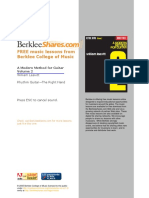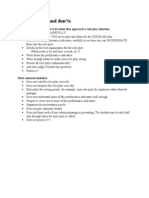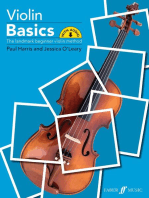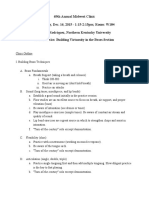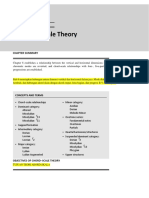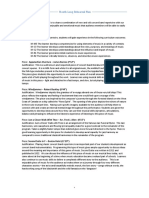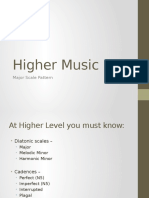Teaching Strings For The Non-String Player: Mid-West Clinic
Teaching Strings For The Non-String Player: Mid-West Clinic
Uploaded by
Alex MoralesCopyright:
Available Formats
Teaching Strings For The Non-String Player: Mid-West Clinic
Teaching Strings For The Non-String Player: Mid-West Clinic
Uploaded by
Alex MoralesOriginal Title
Copyright
Available Formats
Share this document
Did you find this document useful?
Is this content inappropriate?
Copyright:
Available Formats
Teaching Strings For The Non-String Player: Mid-West Clinic
Teaching Strings For The Non-String Player: Mid-West Clinic
Uploaded by
Alex MoralesCopyright:
Available Formats
Teaching Strings for the Non-String Player
Mid-West Clinic
Wednesday, December 16th, 2015
Matthew H. Spieker, D.A.
Professor of Music Education and Violin
Director of Arizona Philharmonic Orchestra
University of Arizona, Fred FoxSchool ofMusic
[email protected]
www.mystringcoach.com
"Ah, music! A magic far beyond all we do here." ~Albus Dumbledore
Outline
Resources - Books
How to Design and Teach a Successful School String and Orchestra Program
Dillon, Jacquelyn A. & Kriechbaum, Casimer G.
Neil A. Kjos, Jr., Publishers ISBN# 0-8497-5400-3
Teaching Strings
Klotman, Robert H.
Schirmer Books ISBN# 0-02-870961-6
Playing the String Game (ISBN# 0-292-73815-3)
The String Play (ISBN# 0-292-77606-3)
Young, Phyllis
University of Texas Press
Building a Successful String and Orchestra Program
Hamann, Donald L. & Gillespie, Robert
Oxford University Press ISBN# 978-0-19-985722-7
Resources - Online
American String Teachers Association (ASTA)
http://www.astaweb.com/
Michael Hopkins
http://stringtechnique.com/index.htm
Todd Ehle
Search YouTube for Professor V
Matt Spieker
http://www.mystringcoach.com/
Resource - Summer Camp
Ohio State University String Teacher Workshop
July 5th - July 11, 2015
http://music.osu.edu/outreach/osu-stw
Two Biggest Complaints About Teaching Strings
They Squeak
They Cant Play in Tune
Tone Production
Three Ingredients to Tone Production
Weight
Produced through the arm
Produced through pronation
Speed
How fast you use the bow, not related to tempo
Bow Placement
Sweet spot
Fingerboard
Bridge
Other Factors
Use of rosin
Quality of bow hair
Dont touch the hair
Quality of the strings
Quality of the instrument
Score
Bow Usage
Music Issues
Long notes need slow bows with more weight
## 3
Score & 4 ! ! !
#
Slurs are an equivalent to long notes
& # #!# 3 ! ! ! ! ! !
8
& 4 ! ! !
## ! ! ! ! ! ! !
16
&#
& # ! ! ! ! ! ! !
8
Score
(Tone Production Continued)
Full bows on short notes create accents
does not necessarily mean the tip
# # 3 !
& 4 J " "
# # Spot
Intonation Step One 8- Note Names
&
Right Finger on the Right " " " " " " "
Fingerboard Mapping
Think of the instrument as a fretted instrument
Note Names vs. Numbers
- #Students who learn numbers dont fully understand key
# the
" notes associated
" " with them
" " " "
16
& and
Problem
Score signatures
A number doesnt have a spot on the instrument but a note does have a
spot, (actually 2 spots)
##
This F natural
Score has only two spots on the instrument
" " " " " " "
24
# # 3 &!
Ex. 1
& 4 j " " "
3 ! 32
Ex. 2
& 4 j # #
" "
"
" "
## " &
" " " " " " "
8
&
" main hand
" frames" " " " " "
Hand
9 Frames
& Four
# # Whole Step, Whole Step, Whole Step
" " Whole"Step, Half" Step " " " "
16
& Whole Step,
Whole Step, Half Step, Whole Step
" " in your "warm-ups" " " " "
17
& Reinforce
Half Step, Whole Step, Whole Step
# # Warm-up examples on www.mystringcoach.com
this
" " " " " " " "
24
&
No
25 Frets Means Muscle Memory
& " memory
Muscle " means" repetition" " " " "
32
##
Dr. Suzuki, Nurtured by Love
"
&
It is a matter of Ease comes with training. We simply have to train and educate our ability, that is to
say to do the thing over and over again until it feels natural, simply and easy. That is the secret. p.51
Score
Intonation Step Two - Wiggle Strings
Sympathetic Vibrations
The most powerful lesson to learn for string players
! as an open
Concept
Playing a note, that has the same3 name
j
& 4to vibrate "
string, will cause the open string
Viola dAmore and Sitars use sympathetic vibrations
Demonstrate on a string bass
? " " " " "
Playing this G
w
Makes the open G wiggle, (a lot!)
First finger Ds on the C string are best for Violas and Cellos
?
First finger A on the G string
Concept " "
are best for violins
" " " "
Best to go from fat strings to thin strings
Still works from thin strings to fat strings
? shape,
Listen for ringing rather than looking for wiggling
Wiggle strings can set the hand " (no stickers
" "
needed) " " "
Violin example
1st finger A on the G string and 3rd finger G on the D string
Intonation - Learn the Perfect Fifth/Fourth
Tuning Open Strings to Reinforce Perfect Fifths and Fourths
Tune your basses first then
Tuning Order
Step One: Bass A / Cello A / Viola A / Violin A
Bass E / Violin E
Tuning Es with the droning As
Step Two: Bass A / Cello A / Viola A / Violin A
Bass D / Cello D / Viola D / Violin D
Tuning Ds with the droning As
Step Three: Bass D / Cello D / Viola D / Violin D
Bass G / Cello G / Viola G / Violin G
Tuning Gs with the droning Ds
Step Four: Bass G / Cello G / Viola G / Violin G
Cello C / Viola C
Tuning Cs with the droning Gs
Benefits of training perfect 5ths every day
Tuning instruments will get faster
Tuning chords will become easier
The fifth is the second interval they need to hear
Remember tuning order
Root, Fifth, Third, Sevenths and other tones
Equal Temperament vs. Just Intonation
Teach this to older students
Most tuners dont help string players
Tonal Energy Tuner
Two great demonstrations
Viola C string
Two Es on the violin
Miscellaneous Items
Warm Ups
Most important part of the day
Directed warm ups for beginning groups to reinforce new concepts
Prescribed warms ups
Reinforce essentials
On the left side then the right side
http://www.mystringcoach.com/Middle_School_Warm_Ups.pdf
http://www.mystringcoach.com/High_School_Warm_Ups.pdf
Thumb placements
Right Thumb
Bent and flexible
Left Thumb
Violin and Viola
Across from the 1st finger
Pointing to the ceiling
Cello and Bass
Horizontal to the fingerboard
Parallel to the floor
Left Elbow Placement
Violin and Viola
Under the arm
Cello and Bass
Up enough to make the wrist straight
Shifting Quick Tips
Make sure thumb goes with the hand
Violins and violas - thumbs with 1st finger
Cellos and basses - thumbs with 2nd finger
Practice position spots with drones
Score
Siren exercise
Marking shifts in the music
Old finger / Dash / New finger
3 ! 1 -1 -2
4
& 4 J " " " " ?
All shifts are 1 to 1
? In the above " " " " " " "
example, second measure, I think 1st finger D down to
w 1st finger B
Higher numbered fingers fall into the appropriate hand frame
? This
Three Levels of Playing
" keeps the
" advanced" students" busy in" a beginning
" class " "
1st Level - Play the notes as is
2nd Level - Play the same notes but in different positions
3rd Level - Play the notes up one octave and in different positions
? " " " " " " " "
Violin
Middle School Warm Ups
! 2
Matthew H. Spieker
w w
Long Tones
4
&4 w w
w w w w
Chromatics 4
& # #
#
#
4
& #
# # # # # #
4
Hand Frame #1 4
& # # # #
4 4
#
0 4
# # #
#
Hand Frame #2 4 4
& # #
0 4
# #
4 4
# #
Hand Frame #3 4 4 4 0 4
& #
4
Hand Frame #4 4 4 4
&
4
&
Two Octave Major Scale
# # n n
Two Octave Melodic Minor Scale
& # # n n
2011
www.mystringcoach.com
Vln. p.2 Middle School Warm Ups
! ! ! "
Bowing Exercises
&
! " . . ! ! " " ! ". ". ! " " !
& . . . . . . .
. . . . . . . . .
! Frog! " ! " ! Frog! j j j !
j j j
J
sim.
&
! ! " " sim.
. . . .
Hook
& . . . . . . . . . . . . .
. . . .
! 3 " 3 ! ! 3 " ! 3
3 3
3 3 3 3
&
! ! !
&
www www
Play one of the three tones of the chords.
www www
Chord Progressions
www www
Your director will give you the chord progression.
& www
I ii iii IV V vi vii
" "U "
Vom Himmel hoch da komm ich her Bach
U
& #
U U
& .
" " J " . " J
You might also like
- MyFirstViolinFunBook PDFDocument34 pagesMyFirstViolinFunBook PDFshuklankita100% (5)
- SAXOFONE - INFANTIL - MÉTODO - Fun Book (Larry Newman)Document40 pagesSAXOFONE - INFANTIL - MÉTODO - Fun Book (Larry Newman)Elda Linos100% (1)
- How To Play The Celtic HarpDocument29 pagesHow To Play The Celtic HarpDougCrouse100% (7)
- String Explorer CoversDocument6 pagesString Explorer CoversNipaul Abrenica0% (1)
- Every Which Way Temperament - SwaffordDocument12 pagesEvery Which Way Temperament - Swaffordjbmfc100% (2)
- Hear Thou The Song of My Heart SatbDocument6 pagesHear Thou The Song of My Heart SatbjesaxNo ratings yet
- Course Pack L1Document88 pagesCourse Pack L1Ernesto Hernandez-TrejoNo ratings yet
- 30 Day Killer Technique Action Plan - CompleteDocument11 pages30 Day Killer Technique Action Plan - CompleteKatherine EncarnacionNo ratings yet
- TTS Scales Appendix PDFDocument33 pagesTTS Scales Appendix PDFNathan “Muffin Man” Glen100% (3)
- Habits of A Successful String OrchestraDocument24 pagesHabits of A Successful String OrchestraAlex MoralesNo ratings yet
- Melodic Devices PDFDocument4 pagesMelodic Devices PDFMalik ANo ratings yet
- Habits Por Conductores PDFDocument12 pagesHabits Por Conductores PDFGualberto Rocha100% (1)
- Secret Is The Right Hand PDFDocument12 pagesSecret Is The Right Hand PDF1872033 Ray Christian KustiawanNo ratings yet
- Scale Practise For SoloingDocument3 pagesScale Practise For Soloinguq2No ratings yet
- 100 Jazz Etudes by Jacob WiseDocument257 pages100 Jazz Etudes by Jacob WiseJusan Beats100% (3)
- Standard Warmup PlanDocument11 pagesStandard Warmup Planvidalmf2005No ratings yet
- Habits of A Successful Wind Ensemble: Cott UshDocument12 pagesHabits of A Successful Wind Ensemble: Cott Ushajohnso18No ratings yet
- Chopin Prelude Op28 No 4 PsiDocument5 pagesChopin Prelude Op28 No 4 PsiHeiko BeyerNo ratings yet
- Musically Useful Scale Practice: by Jason SiffordDocument9 pagesMusically Useful Scale Practice: by Jason SiffordAlexis CutchinsNo ratings yet
- Habits Successful Wind Ensamble PDFDocument12 pagesHabits Successful Wind Ensamble PDFJesus Campo100% (3)
- How To Write For Percussion: A Comprehensive Guide To Percussion Composition Second Edition Solomon All Chapter Instant DownloadDocument62 pagesHow To Write For Percussion: A Comprehensive Guide To Percussion Composition Second Edition Solomon All Chapter Instant Downloaddhammyalsion100% (5)
- Ukulele Lessons by Curt ShellerDocument8 pagesUkulele Lessons by Curt ShellerTea TurnšekNo ratings yet
- Elliec 225 EvalDocument3 pagesElliec 225 Evalapi-206057372No ratings yet
- Bernard Dewagtere: About The ArtistDocument5 pagesBernard Dewagtere: About The ArtistDario Jose Dos Santos100% (1)
- Piano Fingering For ImprovisationDocument17 pagesPiano Fingering For ImprovisationSundoro Gunawan100% (10)
- Grade 7Document76 pagesGrade 7Don Cabillo71% (7)
- Composition Guide #1 - Ternary FormDocument18 pagesComposition Guide #1 - Ternary Formdurmamustafa_6687140No ratings yet
- Six Games For The EFLDocument5 pagesSix Games For The EFLGeorgiana ChelaruNo ratings yet
- [FREE PDF sample] How to write for percussion : a comprehensive guide to percussion composition Second Edition Solomon ebooksDocument55 pages[FREE PDF sample] How to write for percussion : a comprehensive guide to percussion composition Second Edition Solomon ebooksbuerkgalya4a100% (2)
- Beginning Recorders Handout 50m.8.21.16Document2 pagesBeginning Recorders Handout 50m.8.21.16Nancy PosadaNo ratings yet
- Eight Essential Exercises 2022Document72 pagesEight Essential Exercises 2022Debora RosatoNo ratings yet
- ENVision Out and About - MalletsDocument2 pagesENVision Out and About - Malletsgizzy9dillespieNo ratings yet
- Robert Trory Book 1 Excercise From WebsiteDocument9 pagesRobert Trory Book 1 Excercise From Websitesanjivmodi100% (1)
- Theory Study GuideDocument3 pagesTheory Study GuideLiu LaoNo ratings yet
- Rick Kettner - Drummer Essentials ROCK DRUMMINGDocument11 pagesRick Kettner - Drummer Essentials ROCK DRUMMINGHernán FiNo ratings yet
- (Free Scores - Com) Albeniz Isaac Tango 80887Document4 pages(Free Scores - Com) Albeniz Isaac Tango 80887fernando almeidaNo ratings yet
- (Free Scores - Com) Albeniz Isaac Tango 80887Document4 pages(Free Scores - Com) Albeniz Isaac Tango 80887fernando almeidaNo ratings yet
- Final FelizDocument11 pagesFinal Felizgerly suethNo ratings yet
- Cambridge IGCSE: MUSIC 0410/11Document16 pagesCambridge IGCSE: MUSIC 0410/11Kuromi ChangNo ratings yet
- Berklee Rhythm Guitar Basics PDFDocument4 pagesBerklee Rhythm Guitar Basics PDFDoug OhnemusNo ratings yet
- PD60010951 2021 Fsy Musical Program EngDocument28 pagesPD60010951 2021 Fsy Musical Program EngPedro Paku100% (2)
- Daniel Moult: 1. Fingering and TouchDocument3 pagesDaniel Moult: 1. Fingering and TouchAdrianNo ratings yet
- 1 Bach Jesu Joy of Man S DesiringDocument8 pages1 Bach Jesu Joy of Man S DesiringNorberto Vogel IINo ratings yet
- 1 PlicasDocument1 page1 PlicasRegistros AcadémicosNo ratings yet
- Copies May Not Be Sold or Included in Any Materials Offered For Sale To The General PublicDocument1 pageCopies May Not Be Sold or Included in Any Materials Offered For Sale To The General PublicAlexis ArcillasNo ratings yet
- Concerto After Joyce (Score)Document35 pagesConcerto After Joyce (Score)lastdreamsNo ratings yet
- Tiernas Canciones Alzad Al SenorDocument10 pagesTiernas Canciones Alzad Al SenorClaudia Bastías RojasNo ratings yet
- Role Play DOs and DON'TsDocument1 pageRole Play DOs and DON'TsAmruth ReddyNo ratings yet
- Happy Birthday!: Q Q Q Q Q QDocument1 pageHappy Birthday!: Q Q Q Q Q QKostas ManolkidisNo ratings yet
- Enlarge A4 Copies Write Your Own - Ee-Poem' See Below: Page 2 of 2Document24 pagesEnlarge A4 Copies Write Your Own - Ee-Poem' See Below: Page 2 of 2FhaAzmiNo ratings yet
- Satin Doll Bass Line and NotesDocument4 pagesSatin Doll Bass Line and Notesuq2100% (1)
- Art SupplementDocument21 pagesArt SupplementgenegenegenesterNo ratings yet
- EserciziDocument6 pagesEserciziAndrea PernicianoNo ratings yet
- Trumpet Studio Daily Routine: (For Prospective Students)Document39 pagesTrumpet Studio Daily Routine: (For Prospective Students)hector15msf100% (1)
- Adobe Scan 25 сент. 2023 г.Document1 pageAdobe Scan 25 сент. 2023 г.AleksandraNo ratings yet
- Bernard Dewagtere: About The ArtistDocument2 pagesBernard Dewagtere: About The ArtistManuela EkmecicNo ratings yet
- Notes From MichaelDocument41 pagesNotes From MichaeltobyopferNo ratings yet
- 8628HO1 StringsDocument24 pages8628HO1 StringsMohamad reza safaviNo ratings yet
- No Vale La Pena Score Parts ExportDocument26 pagesNo Vale La Pena Score Parts ExportJorge AlvaNo ratings yet
- Dexterity Exercise On The A StringDocument1 pageDexterity Exercise On The A StringNorj Prince FigueroaNo ratings yet
- 06 - Counting Thirty-Second Notes PDFDocument1 page06 - Counting Thirty-Second Notes PDFJonNo ratings yet
- 6 Anthems For Women's VoicesDocument48 pages6 Anthems For Women's VoicesZicheng HuangNo ratings yet
- 11 - Solo Construction 140-149 PDFDocument5 pages11 - Solo Construction 140-149 PDFJimmy ZambranoNo ratings yet
- Piecing the Piece O' Cake Way: A Visual Guide to Making Patchwork Quilts - New! Color Theory, Improv Piecing, 10 Fresh Projects & MoreFrom EverandPiecing the Piece O' Cake Way: A Visual Guide to Making Patchwork Quilts - New! Color Theory, Improv Piecing, 10 Fresh Projects & MoreNo ratings yet
- Rhythm, Rhythm, Rhythm: Teaching The Most Important Thing in Music. Strategies For The Instrumental ClassroomDocument6 pagesRhythm, Rhythm, Rhythm: Teaching The Most Important Thing in Music. Strategies For The Instrumental ClassroomAlex MoralesNo ratings yet
- Sound Reinforcement and Recording of Jazz and Large Ensembles - Practical and Easy To Use Basic and Advanced IdeasDocument9 pagesSound Reinforcement and Recording of Jazz and Large Ensembles - Practical and Easy To Use Basic and Advanced IdeasAlex Morales100% (1)
- Shujitsu Jr. & Sr. High School Band, Okayama, JapanDocument2 pagesShujitsu Jr. & Sr. High School Band, Okayama, JapanAlex MoralesNo ratings yet
- Arnold Jacobs: Mentor, Teacher, Friend: Midwest Clinic, Friday, December 18 12:00-1:00pmDocument14 pagesArnold Jacobs: Mentor, Teacher, Friend: Midwest Clinic, Friday, December 18 12:00-1:00pmAlex MoralesNo ratings yet
- Rehearsal Strategies: Lead Get Out of The Way! Follow &Document8 pagesRehearsal Strategies: Lead Get Out of The Way! Follow &Alex MoralesNo ratings yet
- Solving The Woodwind Puzzle: Five Instruments, Three Big IdeasDocument8 pagesSolving The Woodwind Puzzle: Five Instruments, Three Big IdeasAlex MoralesNo ratings yet
- 69th Annual Midwest Clinic Wednesday, Dec. 16, 2015 - 1:15-2:15pm Room: W184 Raquel Rodriquez, Northern Kentucky University Brass Tactics: Building Virtuosity in The Brass SectionDocument3 pages69th Annual Midwest Clinic Wednesday, Dec. 16, 2015 - 1:15-2:15pm Room: W184 Raquel Rodriquez, Northern Kentucky University Brass Tactics: Building Virtuosity in The Brass SectionAlex MoralesNo ratings yet
- I Me A Clinic Quotes SourcesDocument8 pagesI Me A Clinic Quotes SourcesAlex MoralesNo ratings yet
- Achieving Your Ensemble Sound:: It's Fundamental!Document17 pagesAchieving Your Ensemble Sound:: It's Fundamental!Alex Morales100% (1)
- Oboe Reed Adjustment Guide For Music EducatorsDocument2 pagesOboe Reed Adjustment Guide For Music EducatorsAlex MoralesNo ratings yet
- The "IT" Factor in School Orchestra Literature: Why Is Repertoire Secelection Important?Document3 pagesThe "IT" Factor in School Orchestra Literature: Why Is Repertoire Secelection Important?Alex MoralesNo ratings yet
- The Midwest Clinic: Figure 1 - Arrows Indicate Correct Top and Bottom Teeth PlacementDocument6 pagesThe Midwest Clinic: Figure 1 - Arrows Indicate Correct Top and Bottom Teeth PlacementAlex MoralesNo ratings yet
- Marches Are Music! PDFDocument7 pagesMarches Are Music! PDFAlex MoralesNo ratings yet
- What Is A Musical PerformanceDocument1 pageWhat Is A Musical PerformanceAlex MoralesNo ratings yet
- Arnold Jacobs: His Global Influence: Midwest Clinic, Thursday, December 17 12:00-1:00pmDocument17 pagesArnold Jacobs: His Global Influence: Midwest Clinic, Thursday, December 17 12:00-1:00pmAlex MoralesNo ratings yet
- 2013-2014 HandbookDocument13 pages2013-2014 HandbookAlex MoralesNo ratings yet
- Braden River High School Marching Band of PiratesDocument19 pagesBraden River High School Marching Band of PiratesAlex MoralesNo ratings yet
- 2014-2015 CB HandbookDocument11 pages2014-2015 CB HandbookAlex MoralesNo ratings yet
- Tempi WordsDocument1 pageTempi WordsAlex MoralesNo ratings yet
- 2014-2015 Keller High School Indian Band HandbookDocument25 pages2014-2015 Keller High School Indian Band HandbookAlex MoralesNo ratings yet
- Braden River High School BandsDocument2 pagesBraden River High School BandsAlex MoralesNo ratings yet
- All Music Must DanceDocument13 pagesAll Music Must DanceAlex MoralesNo ratings yet
- Rehearsing With Commitment - Mallory ThompsonDocument9 pagesRehearsing With Commitment - Mallory ThompsonAlex Morales100% (1)
- Tone WordsDocument1 pageTone WordsAlex MoralesNo ratings yet
- ListBMusicalsTeacher VersionDocument14 pagesListBMusicalsTeacher VersionwndaudiaoidwNo ratings yet
- Ovox Vocal ResynthesisDocument37 pagesOvox Vocal ResynthesismrgreengenesNo ratings yet
- Unit6-Lab - Part2 - Velocity of The SoundDocument3 pagesUnit6-Lab - Part2 - Velocity of The Soundfarooq pervezNo ratings yet
- Harmonising With 7th Chords PDFDocument2 pagesHarmonising With 7th Chords PDFterzianoNo ratings yet
- Forgotten in TimeDocument21 pagesForgotten in TimelowtarhkY100% (3)
- CHORDDocument24 pagesCHORDYosua ErikoNo ratings yet
- NB Transeamus Us Que BetlehemDocument4 pagesNB Transeamus Us Que BetlehemLily TanNo ratings yet
- Triad DiminishedDocument14 pagesTriad DiminishedSteven RojasNo ratings yet
- ELASTIK 3 5 Manual-EnglishDocument18 pagesELASTIK 3 5 Manual-EnglishJosé Andrés Prieto Franco100% (1)
- Screenshot 2023-08-17 at 11.36.09 PMDocument1 pageScreenshot 2023-08-17 at 11.36.09 PMSyed Ali SajjadNo ratings yet
- ABCDocument65 pagesABCocseuNo ratings yet
- Lista de Precios - Oferta.Document8 pagesLista de Precios - Oferta.wallaudioyequipamientosNo ratings yet
- What Was I Made For? SATBDocument8 pagesWhat Was I Made For? SATBRobyn ColvanNo ratings yet
- Major Scales For Piano Two Octave FingeringsDocument4 pagesMajor Scales For Piano Two Octave FingeringsCasey KnoxNo ratings yet
- MUSC2060 Assignment Two - 2013Document3 pagesMUSC2060 Assignment Two - 2013lanijeffries84No ratings yet
- Mozart KV 297 copieDocument40 pagesMozart KV 297 copieCharlotte LesfillesNo ratings yet
- LazyAssGuitarHacks v1Document16 pagesLazyAssGuitarHacks v1A21Joker100% (3)
- Ludwig Senfl, Fantasia For RecordersDocument3 pagesLudwig Senfl, Fantasia For Recorderserhan savasNo ratings yet
- Just Intonation Guitar Designs+Linear MicrotemperamentsDocument23 pagesJust Intonation Guitar Designs+Linear MicrotemperamentsGeorge Christian Vilela Pereira100% (1)
- Review and Checking of The Assignment Enharmonics Answers: C# or DB D# or Eb F# or GB G# or Ab A# or BB Optional: Eorfb Borcb Nashville Number SystemDocument4 pagesReview and Checking of The Assignment Enharmonics Answers: C# or DB D# or Eb F# or GB G# or Ab A# or BB Optional: Eorfb Borcb Nashville Number SystemGabriel RamosNo ratings yet
- Month Long Rehearsal Plan - FinalDocument11 pagesMonth Long Rehearsal Plan - Finalapi-273975851No ratings yet
- 0306neapolitansix PDFDocument1 page0306neapolitansix PDFAloysius JulindraNo ratings yet
- Higher Music: Major Scale PatternDocument7 pagesHigher Music: Major Scale PatternJenna Watson HoodNo ratings yet
- AVE MARIA CACCINI Voces PDFDocument4 pagesAVE MARIA CACCINI Voces PDFTaki Charangoman KapchiyNo ratings yet
- (Lost Frequencies) Reality - Tuấn Sáng TốiDocument3 pages(Lost Frequencies) Reality - Tuấn Sáng TốiNgoc Hieu NguyenNo ratings yet
- Loudness Pitch of SoundDocument10 pagesLoudness Pitch of SoundMoh AmedNo ratings yet









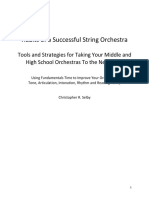


















![[FREE PDF sample] How to write for percussion : a comprehensive guide to percussion composition Second Edition Solomon ebooks](https://imgv2-1-f.scribdassets.com/img/document/807115907/149x198/3fa72f7815/1734907654?v=1)










